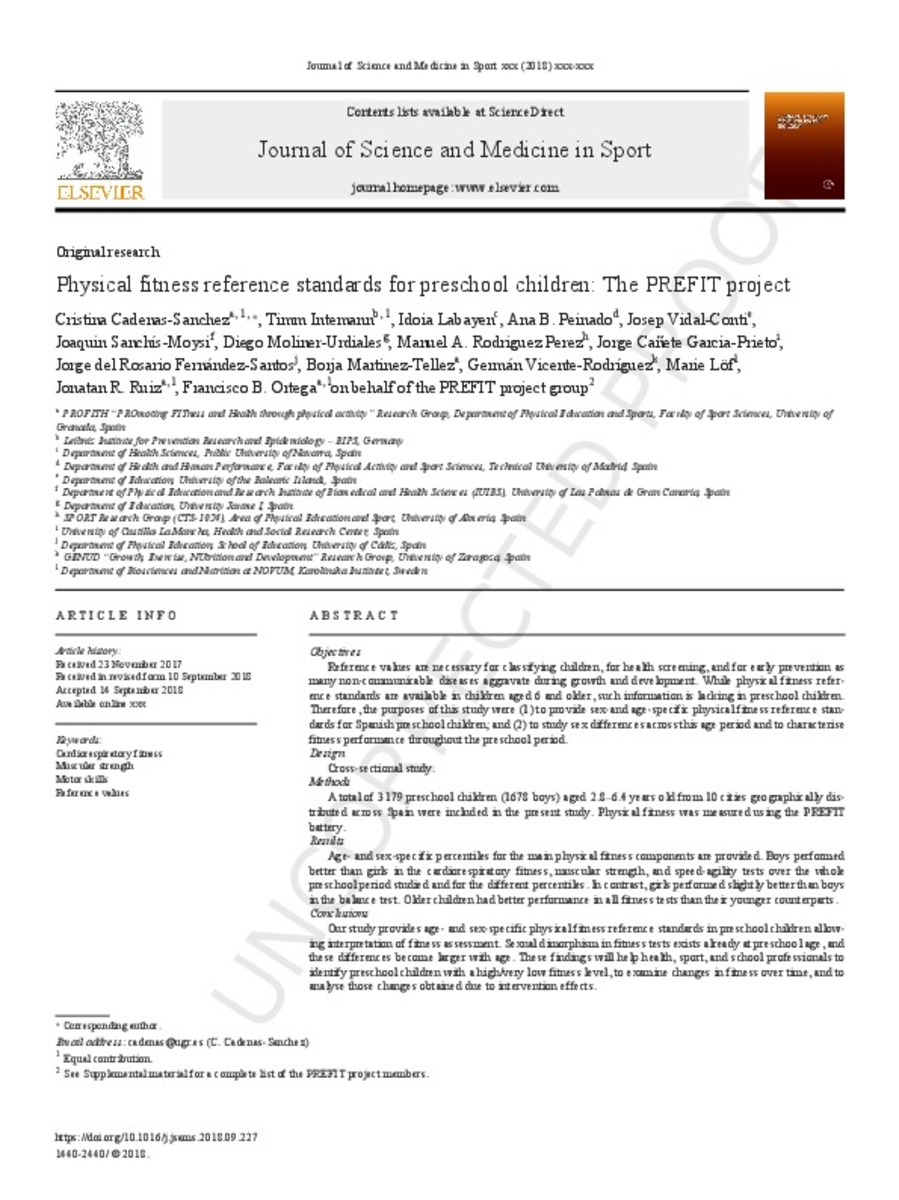Mostrar el registro sencillo del ítem
Physical fitness reference standards for preschool children: The PREFIT project
| dc.contributor.author | Cadenas-Sanchez, Cristina | |
| dc.contributor.author | Intemann, Timm | |
| dc.contributor.author | LABAYEN , IDOIA | |
| dc.contributor.author | Peinado, Ana B. | |
| dc.contributor.author | SANCHIS-MOYSI, JOAQUIN | |
| dc.contributor.author | Moliner-Urdiales, Diego | |
| dc.contributor.author | Rodríguez Pérez, Manuel A. | |
| dc.contributor.author | Cañete García-Prieto, Jorge | |
| dc.contributor.author | Fernández-Santos, Jorge del Rosario | |
| dc.contributor.author | Martínez-Tellez, Borja | |
| dc.contributor.author | Vicente Rodríguez, Germán | |
| dc.contributor.author | Löf, Marie | |
| dc.contributor.author | Ruiz, Jonatan R. | |
| dc.contributor.author | Ortega, Francisco B. | |
| dc.contributor.author | PREFIT project group | |
| dc.date.accessioned | 2018-11-15T12:32:57Z | |
| dc.date.available | 2018-11-15T12:32:57Z | |
| dc.date.issued | 2018-09 | |
| dc.identifier.citation | CADENAS-SANCHEZ, Cristina, et al. Physical fitness reference standards for preschool children: The PREFIT project. Journal of science and medicine in sport, 2018. | ca_CA |
| dc.identifier.uri | http://hdl.handle.net/10234/177506 | |
| dc.description.abstract | Objectives Reference values are necessary for classifying children, for health screening, and for early prevention as many non-communicable diseases aggravate during growth and development. While physical fitness reference standards are available in children aged 6 and older, such information is lacking in preschool children. Therefore, the purposes of this study were (1) to provide sex-and age-specific physical fitness reference standards for Spanish preschool children; and (2) to study sex differences across this age period and to characterise fitness performance throughout the preschool period. Design Cross-sectional. Methods A total of 3179 preschool children (1678 boys) aged 2.8–6.4 years old from Spain were included in the present study. Physical fitness was measured using the PREFIT battery. Results Age- and sex-specific percentiles for the physical fitness components are provided. Boys performed better than girls in the cardiorespiratory fitness, muscular strength, and speed-agility tests over the whole preschool period studied and for the different percentiles. In contrast, girls performed slightly better than boys in the balance test. Older children had better performance in all fitness tests than their younger counterparts. Conclusions Our study provides age- and sex-specific physical fitness reference standards in preschool children allowing interpretation of fitness assessment. Sexual dimorphism in fitness tests exists already at preschool age, and these differences become larger with age. These findings will help health, sport, and school professionals to identify preschool children with a high/very low fitness level, to examine changes in fitness over time, and to analyse those changes obtained due to intervention effects. | ca_CA |
| dc.format.extent | 9 p. | ca_CA |
| dc.format.mimetype | application/pdf | ca_CA |
| dc.language.iso | eng | ca_CA |
| dc.publisher | Elsevier | ca_CA |
| dc.rights | © 2018 Sports Medicine Australia. Published by Elsevier Ltd. All rights reserved. | ca_CA |
| dc.rights.uri | http://rightsstatements.org/vocab/InC/1.0/ | * |
| dc.subject | cardiorespiratory fitness | ca_CA |
| dc.subject | muscular strength | ca_CA |
| dc.subject | motor skills | ca_CA |
| dc.subject | reference values | ca_CA |
| dc.title | Physical fitness reference standards for preschool children: The PREFIT project | ca_CA |
| dc.type | info:eu-repo/semantics/article | ca_CA |
| dc.identifier.doi | https://doi.org/10.1016/j.jsams.2018.09.227 | |
| dc.relation.projectID | FBO. Ramón y Cajal grant (RYC-2011-09011) ; Spanish Ministry of Economy and Competitiveness (BES-2014-068829) ; Spanish Ministry of Science and Innovation (RYC-2010-05957 and RYC-2011-09011) ; SAMID III network, RETICS, funded by the PN I + D + I 2017-2021 (Spain), ISCIII- Sub-Directorate General for Research Assessment and Promotion, the European Regional Development Fund (ERDF) (Ref. RD16/0022) ; EXERNET Research Network on Exercise and Health in Special Populations (DEP2005-00046/ACTI) ; University of the Basque Country (GIU14/21) ; the University of Zaragoza (JIUZ-2014-BIO-08) | ca_CA |
| dc.rights.accessRights | info:eu-repo/semantics/openAccess | ca_CA |
| dc.relation.publisherVersion | https://www.sciencedirect.com/science/article/pii/S1440244018309113 | ca_CA |
| dc.date.embargoEndDate | 2020-09 | |
| dc.contributor.funder | University of Granada, Plan Propio de Investigación 2016, Excellence actions: Units of Excellence; Unit of Excellence on Exercise and Health (UCEES) | ca_CA |
| dc.type.version | info:eu-repo/semantics/updatedVersion | ca_CA |
Ficheros en el ítem
Este ítem aparece en la(s) siguiente(s) colección(ones)
-
EDU_Articles [500]







